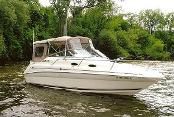So this person told you that they heard of a guy who’s outdrive was ruined from stray voltage corrosion and the offending boat was another boat in the marina.
Stories like this are great at putting fear in us boaters. It has all the making of a good horror film. You can’t see the culprit, you can’t detect it and you fear your boat may be under attack right now. What can you do?
What is electrolysis?
Electrolysis is a reaction between metal and electrical current. Electrolysis occurs when electrical current comes in contact with water near the external metallic parts of your boat.
This electrical current normally comes from an improperly grounded electrical devices or an electrical device that has suffered a short or fault and now has the live or hot side of the electricity in contact with the water.
Electrolysis can cause corrosion much faster then normal galvanic corrosion.
The most expensive external metallic component of your boat is the outdrive often called “the lower unit.” As electrons flow from negative to positive or from your outdrive (the negative source) to the leak (the positive source) the electrons literally carry away the metal of your boat bit by bit.
Most insurance companies do not cover claims against marine electrolysis corrosion. Because of a debate over the very word “electrolysis” the insurance companies do not need to put this exclusion in their policies.
Here is the good news.
In this part of the country we have FRESH water not salt water. Electricity travels through salt water much easier then fresh water. Distance in fresh water maters greatly. 120 volts (a measurement of electrical pressure) in fresh water means the electricity can only travel a short distance to reach your outdrive. Stories of one boat on one pier causing electrolysis on a boat on a different pier are possible but highly unlikely in fresh water. Your own boat and the boats immediately adjacent to your slip or other electrical sources close to your slip are the sources of concern.
What can you do?
Before you hire an electrician and spend money here is how you can tell if you have a problem. This is a test that any boater that keeps their boat in a slip can and should do. Inspect your anodes on your outdrive on a regular basis. These are the silver colored metallic parts on your outdrive. If you have a Mercury Alpha I you have 6 anodes. 5 are visible and 1 is behind the propeller.
Even if you have stray current causing dramatically accelerated corrosion your anodes will function and sacrifice themselves first.
Put on a full set of new magnesium anodes. If they are 50% gone in 6 months to a year this is considered normal wear. With the short season of Wisconsin we can normally go 1 full season in a wet slip then change the anodes during the winter maintenance schedule. If you see uneven wear, say one anode on one trim shaft has had much less mass then the other you need to remove this larger anode and sand the surface area between the anode and the metal the anode touches. The anode is larger because it’s not making good contact and is not doing its job.
Anode mass loss (wear) may be less if you keep your lower unit in the full down position when you leave the boat, if you keep your boat in the water for a shorter season, if you have a very well sealed and painted outdrive or if you do not have a bottom painted boat.
Anode mass loss may be more if you have fresh bottom paint (containes copper) or have an stainless steel propeller. This is becaus stailess steel is a very nobel or low croding metal causing a increased rate of galvanic conversion to the anodes. Dual stainless steel propellers accelerate this further.
If you are seeing signs of flaking paint or corrosion on your outdrive this is a indication that someone before you (or possibly you but lets blame someone else, its more fun) painted over improperly prepared or even a corroded outdrive. You need to sand, seal, prime and paint this area. Left untreated, this will cause your anodes to dissolve much faster then normal.
If the tip of your skeg (lowest fin on the outdrive) is bare aluminum from running thru shallow areas then you need to sand, seal, prime and paint this area. Left untreated, this also will cause your anodes to dissolve much faster then normal. Also, do you have shore power? If yes, you need a galvanic isolator. With out a galvanic isolator you may be causing your own electrolysis problem.
Due to all the metallic items on a boat all boats have an electrical potential. Electrolysis is stray current escaping from the system. When this happens it will reduce the mass of the anodes at a very fast rate leaving the anode metal looking bright and shiny.
Therefore:
Shiny eroded anodes = electrolysis. This is stray voltage induced corrosion and needs to be fixed.
Dull eroded zincs = galvanism. This is dissimilar metal corrosion and will occur naturally on boats kept in a wet slip at a pace of the anode loosing about half its mass after six months. Faster then this and you need to repaint your outdive.
Lets review:
- You start the season with new anodes and they are the proper anodes for your type of water (fresh water = magnesium, salt water = zinc)
- Your outdive is properly sealed and painted. The paint looks good and you see no signs of the paint flaking or corrosion.
- If you have shore power you have a galvanic isolator.
What should you do if you think you have a electrolysis (stray voltage) issue?
If and only if all the above are true yet your anodes are still wearing at a accelerated rate meaning they are reduced to half their original mass in less then 6 months you should hire an marine electrician to check for a possible electrolysis (stray voltage) issue.
What will they do? I don’t want anyone here to do this. Leave this to a trained professional marine electrician.
Here is what they will do. They will take a voltage meter and connect one end to the ground of your shore power. They will then dip the other lead in the water and determine if the voltage is high enough to be considered stray voltage.
The electrician will check if at least 1/2 volts DC or direct current exists.
An amount of DC voltage is normal and will be absorbed with normal anode wear. A boat that has a fresh coat of copper based bottom paint can generate ¼ to 1/3 volt with no connection to shore power and the battery removed.
If you have ¼ to 1/3 volts DC you do not have a problem. If you have ½ volts DC you likely have a problem. If you get to 1 volt DC you have a significant problem. 10 volts and your anodes will be reduced in mass and ineffective in as little as 2 weeks.
If the electrician finds at least ½ volt present the electrician will have one person keep an eye on the meter as another person unplugs your boat. If the meter drops the problem is from your own boat. They will repeat this unplugging your battery cables. In fresh water if there is a stray voltage problem this is the most typical case.
If after unplugging your boat the voltage remains they next will, with the permission of the marina, unplug one boat then the next then anything else in the general area. When something is unplugged and the voltage meter drops the electrical leak source has been found.
Finally, if the electrician determines your slip in the marina is hot, meaning it contains stray voltage and the source is not from your boat but you just can not find or stop the source you need to move to another slip or marina.
The above information was prepared by Presentation Rentals a audiovisual equipment rental company in Appleton Wisconsin that offers LCD projector PA public address sound system and accessories. Visit them on the web at http://www.presentationrentals.net
Boat - SeaRay Sundancer 240
Port - Slip #2A, Skipper Buds, Oshkosh, WI
Lisa


1 comment:
Saw your post on searayowners.com requesting 280DA clearance info.
Overall height is 10'-7" the keel draft is 1'-9 3/8" but that's based on max load. Clearance should be based on min load, so est about 9'-1" but I would want a few inches to spare for wake and stuff. (Not a Sea Ray Owner, so I can't respond directly to the post.)
wolferon@bellsouth.net
Post a Comment